This September marks a thrilling release for cinephiles and motorcycle enthusiasts alike, as the BFI unveils its Blu-ray edition of Don Sharp’s 1973 cult classic, Psychomania. This film, a unique blend of occult themes and the raw energy of 70s biker gangs, perfectly encapsulates a fascinating subgenre: Biker Movies. These films, roaring onto screens since the mid-20th century, capture our collective fascination with motorcycles, often intertwining them with rebellion, freedom, and the open road. Psychomania, with its undead motorcycle gang, serves as an exciting entry point into the world of biker cinema, a world we’re about to explore.
Motorcycle gangs first gripped the cinematic imagination in the early 1950s. While initial depictions were sporadic, the genre gained momentum through the mid-60s. The cultural landscape shifted dramatically with Hunter S. Thompson’s 1966 book, Hell’s Angels: The Strange and Terrible Saga of the Outlaw Motorcycle Gangs, and the infamous 1969 Altamont Speedway concert. These events propelled the image of outlaw motorcycle gangs into the popular consciousness, reaching a fever pitch of public intrigue and, at times, fear. Hollywood responded with a surge of outlaw biker movies. However, biker movies are not solely about lawlessness. Beyond the archetype of the criminal gang, motorcycles in film have consistently represented the yearning for freedom, the quest for self-discovery, and a potent symbol of counter-culture.
Here, we delve into 10 essential films where motorcycles are not just props, but integral characters in narratives of rebellion, identity, and the American (and sometimes British or Australian) spirit.
The Wild One (1953)
Director: László Benedek
 Marlon Brando in The Wild One (1953) leaning on his motorcycle
Marlon Brando in The Wild One (1953) leaning on his motorcycle
The Wild One single-handedly ignited the public’s fascination with motorcycle gangs, transforming a relatively unknown postwar phenomenon into a cultural touchstone. Marlon Brando’s portrayal of Johnny Strabler, the brooding and defiant leader of the Black Rebels Motorcycle Club, became instantly iconic. The film established a recurring theme in biker movies: a disruptive gang invading a tranquil small town, exposing the underlying tensions and hypocrisies within middle-class society.
Beyond Brando’s magnetic performance, The Wild One incorporated authenticity by casting actual bikers. Reportedly, much of the Black Rebels’ dialogue stemmed from conversations producer Stanley Kramer had with these biker extras. This included Brando’s legendary, nihilistic response to the question, “What are you rebelling against?” – “Well, what ya got?” Despite the gang’s relatively clean-cut image compared to later, more extreme biker films, The Wild One sparked considerable controversy for its time. It faced a ban from the British Board of Film Classification and remained prohibited in the UK until 1967, finally released with an X certificate after local councils challenged the initial decision.
The Leather Boys (1964)
Director: Sidney J. Furie
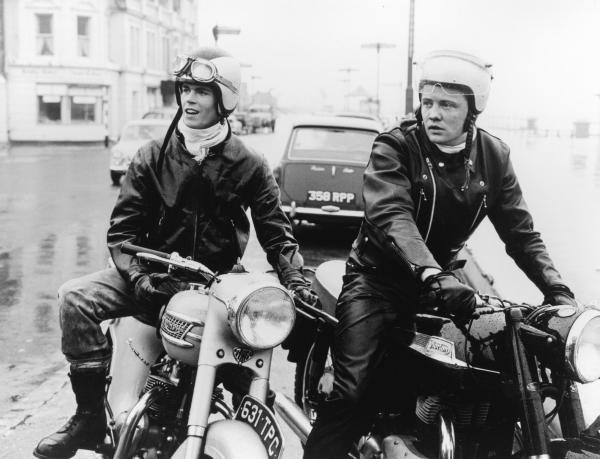 Dudley Sutton and Colin Campbell with Triumph Bonneville motorcycles in The Leather Boys (1964)
Dudley Sutton and Colin Campbell with Triumph Bonneville motorcycles in The Leather Boys (1964)
Sidney J. Furie’s The Leather Boys offers a gritty, kitchen-sink realist perspective on Britain’s rocker subculture, the UK counterpart to American motorcycle gangs. Adapted by Gillian Freeman from her novel, the screenplay centers on Reggie (Colin Campbell) and Dot (Rita Tushingham), two young south London rockers who impulsively marry. Their youthful relationship is tested by Reggie’s narrow-mindedness, Dot’s self-absorption, and their shared immaturity. As their marriage unravels, Reggie finds camaraderie with fellow rocker Pete (Dudley Sutton), exploring deeper emotional connections and life’s broader questions, oblivious to Pete’s romantic interest in him that extends beyond mere mateship and thrilling rides on their 650cc Triumph Bonnevilles.
The Leather Boys is a poignant and insightful exploration of early 60s rocker culture and is now recognized as a significant early work of queer cinema, subtly portraying themes of same-sex desire within a seemingly heteronormative context.
The Wild Angels (1966)
Director: Roger Corman
 The Wild Angels (1966) movie poster featuring Peter Fonda and Nancy Sinatra
The Wild Angels (1966) movie poster featuring Peter Fonda and Nancy Sinatra
Released in the same year as Hunter S. Thompson’s immersive journalistic account of outlaw bikers, Roger Corman’s The Wild Angels provided Peter Fonda with his breakout big-screen role. He embodies ‘Heavenly Blues’, the nihilistic leader of a fictionalized chapter of the San Pedro Hells Angels.
A mission to retrieve a stolen motorcycle leads to the gang’s second-in-command, ‘Loser’ (Bruce Dern), being hospitalized under police watch. Heavenly Blues and his ‘old lady’, Mike (Nancy Sinatra), orchestrate a daring breakout. However, Loser succumbs to his injuries shortly after, culminating in a notorious sequence where the gang desecrates a church and clashes violently with local townsfolk. The Wild Angels blends motorbikes, leather jackets, and Nazi-inspired symbols with a beatnik aesthetic of black skivvies, berets, and a surf rock soundtrack, lending the outlaw bikers a peculiar counter-culture vibe. Adding to its gritty realism, The Wild Angels featured genuine members of the Hells Angels and Coffin Cheaters biker gangs.
The Born Losers (1967)
Director: Tom Laughlin
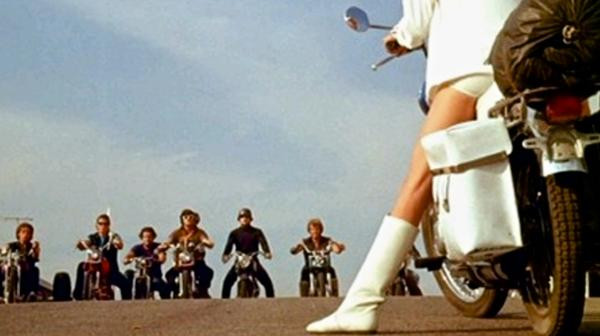 Bikers in The Born Losers (1967) confront Tom Laughlin
Bikers in The Born Losers (1967) confront Tom Laughlin
The Born Losers marked the debut of Billy Jack (played and directed by Tom Laughlin across four films), an enigmatic, nature-loving, half-Native American, former Green Beret, and champion of the counterculture. In this initial installment, a menacing biker gang terrorizes a small Californian coastal town, committing acts of sexual assault and intimidating victims to prevent police cooperation. Billy Jack is drawn into conflict when he becomes the accidental protector of Vicky (Elizabeth James), one of the assaulted girls.
Despite its made-for-television production quality – filmed in a mere three weeks on a shoestring budget – The Born Losers resonated deeply with countercultural sentiments. The film addresses generational divides, racial prejudice, and the challenges faced by veterans reintegrating into civilian life. Crucially, it tackles the impact of sexual violence with sensitivity, moving beyond mere exploitation often found in similar films. Initially a box office disappointment, The Born Losers found phenomenal success upon its 1973 re-release, earning over $40 million.
The Girl on a Motorcycle (1968)
Director: Jack Cardiff
 Marianne Faithfull in The Girl on a Motorcycle (1968) close up
Marianne Faithfull in The Girl on a Motorcycle (1968) close up
The Girl on a Motorcycle (also known as Naked under Leather) stars Marianne Faithfull as Rebecca, a restless young housewife who leaves her sleeping husband to embark on a motorcycle journey to meet her lover, Daniel (Alain Delon), a pipe-smoking university professor. Embracing the spirit of the 60s, Rebecca makes the trip clad in full leather gear, astride a Harley Davidson, a gift from Daniel.
Based on a novel by French surrealist writer André Pieyre de Mandiargues, The Girl on a Motorcycle prioritizes visual and sensory experience over dialogue and plot. The film is rich in psychedelic special effects and nudity, particularly featuring Faithfull. The motorcycle is presented as a tool for female emancipation, a unique twist on the late 60s trope of the dissatisfied housewife rebelling against her mundane existence. However, this theme is somewhat undermined by the film’s melancholic ending. Director Jack Cardiff is celebrated for his distinguished career as a Technicolor cinematographer, collaborating with renowned directors like Powell & Pressburger, Alfred Hitchcock, and John Huston.
Easy Rider (1969)
Director: Dennis Hopper
 Peter Fonda and Dennis Hopper riding motorcycles in Easy Rider (1969)
Peter Fonda and Dennis Hopper riding motorcycles in Easy Rider (1969)
1969 was a watershed year for biker movies, with at least a dozen releases. Easy Rider stands as the most iconic and culturally significant of these. Directed by and starring Dennis Hopper alongside Peter Fonda, the film follows Wyatt (Fonda) and Billy (Hopper) as they ride from Los Angeles to New Orleans on Harley Davidson choppers (famously purchased second-hand from the LAPD) in a quest to ‘discover America’. Their journey exposes them to a diverse cross-section of American society – from struggling farmers and free-spirited individuals to prejudiced rednecks. They encounter George Hanson, a small-town, liberal lawyer played memorably by Jack Nicholson, and share a psychedelic experience with two prostitutes in a New Orleans graveyard, one of whom is a young Karen Black.
Easy Rider oscillates between celebrating masculine Americana and exploring post-Summer of Love disillusionment. While undeniably impactful, its simplistic, pseudo-spiritual undertones feel somewhat dated today. Nevertheless, Easy Rider remains an American cinematic landmark, revered for its striking visuals, groundbreaking soundtrack, and its pivotal role in paving the way for the New Hollywood era of the early 1970s.
Electra Glide in Blue (1973)
Director: James William Guercio
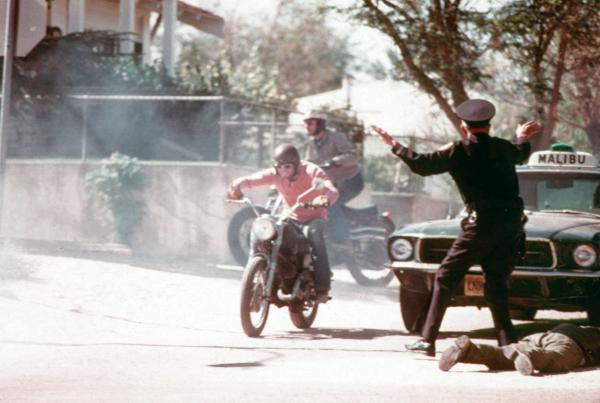 Robert Blake as a police motorcyclist in Electra Glide in Blue (1973)
Robert Blake as a police motorcyclist in Electra Glide in Blue (1973)
Electra Glide in Blue takes its name from the Harley-Davidson Electra Glide motorcycle model ridden by its protagonist, John Wintergreen (Robert Blake), a gentle Vietnam veteran and Arizona highway patrolman. Discontent with his mundane traffic duties and disillusioned by his colleagues’ attitudes, Wintergreen aspires to become a homicide detective. His ambition is ignited when he is first on the scene of an apparent shotgun suicide of an elderly recluse, and is mentored by Poole (Mitchell Ryan), a hard-boiled, right-wing detective.
This exceptional neo-noir film is the sole directorial feature credit of James William Guercio, a Grammy-winning music producer and original guitarist for Frank Zappa and the Mothers of Invention. Enhanced by Conrad Hall’s breathtaking cinematography, Electra Glide in Blue delivers a sharp and poignant portrayal of America’s fading counterculture and the domestic repercussions of the Vietnam War, arguably one of the most insightful cinematic depictions of this tumultuous period.
Stone (1974)
Director: Sandy Barbutt
 Bikers wearing black helmets in Stone (1974)
Bikers wearing black helmets in Stone (1974)
Stone, a lesser-known precursor to the Australian Ozploitation classic Mad Max (1979), blends Australian masculine road culture, biker gangs, and elements of the paranoid conspiracy thrillers popular in the early 70s. The film centers on Stone (Ken Shorter, a former police officer in real life), an unconventional policeman tasked with going undercover within a satanic outlaw biker gang called the Gravediggers, after a mysterious assassin begins targeting its members.
Stone is the directorial debut and swansong of television actor Sandy Harbutt. It features a distinguished Australian cast, including Rebecca Gilling, Bill Hunter, and Helen Morse. Initially dismissed by critics, Stone became a massive hit in Australia, largely due to its impressive stunt work and sheer spectacle, which belied its low budget. Reportedly, hundreds of real-life bikers participated in the film’s most famous scene – a highway funeral procession for a deceased Gravedigger – allegedly compensated with beer.
Quadrophenia (1979)
Director: Franc Roddam
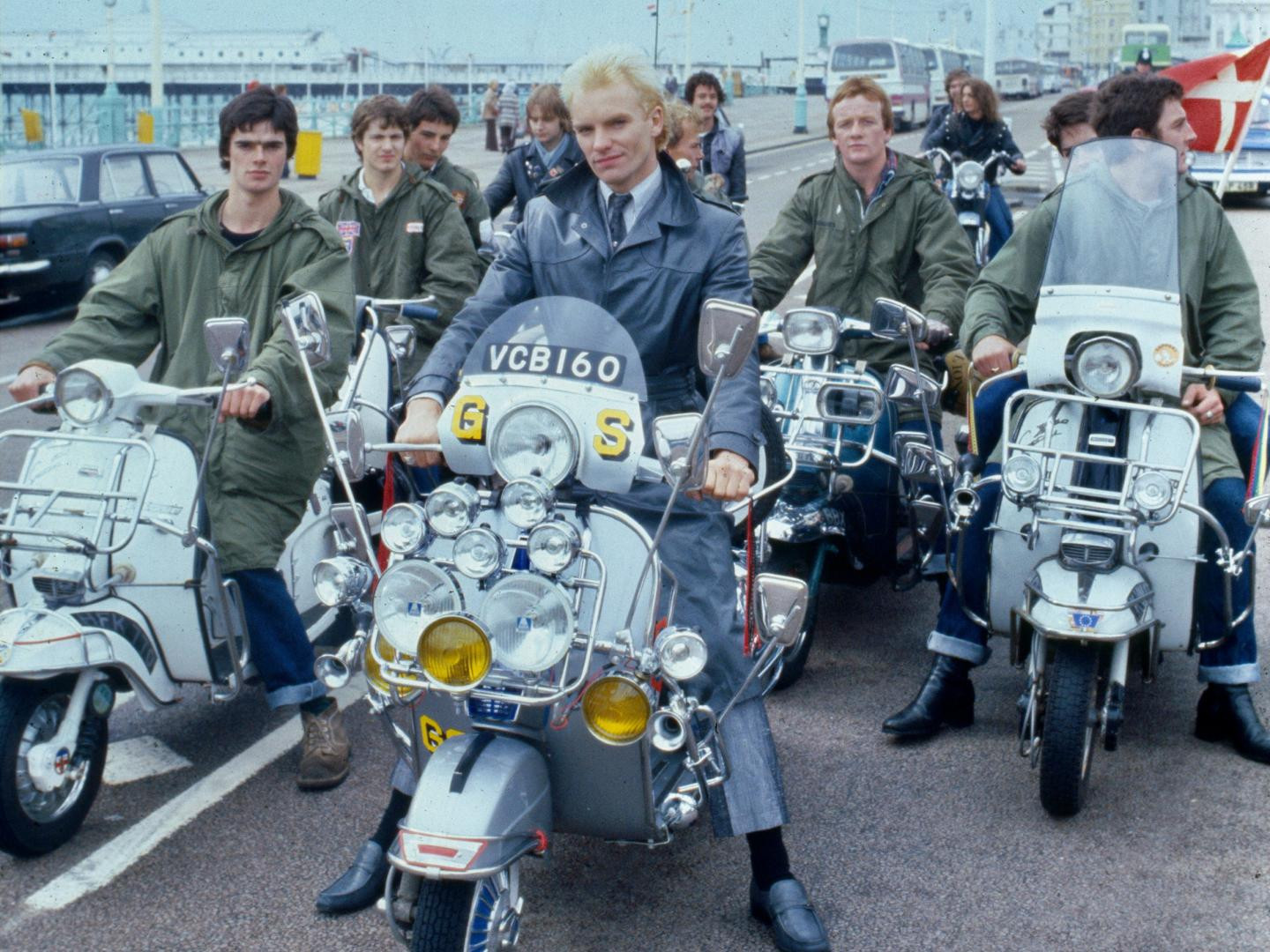 A group of Mods on scooters in Quadrophenia (1979)
A group of Mods on scooters in Quadrophenia (1979)
Quadrophenia, set in 1960s London, is a coming-of-age story of youthful discontent, unfolding against the backdrop of the 1964 bank holiday clashes between Mods and Rockers, violent confrontations that resulted in numerous hospitalizations and arrests. Jimmy (Phil Daniels) embodies the classic juvenile delinquent rebel, enduring a monotonous weekday job to fuel his weekend scooter escapades with his Mod friends and his pursuit of the aloof Steph (Leslie Ash).
While the film’s central narrative – Jimmy’s gradual disillusionment with the Mod lifestyle – might seem somewhat familiar today, Quadrophenia retains its impactful resonance. The film vividly depicts pre-swinging London and its two dominant youth subcultures. The extended riot scenes in Brighton possess a raw, visceral energy, and the film is underpinned by a timeless soundtrack from The Who.
The Motorcycle Diaries (2004)
Director: Walter Salles
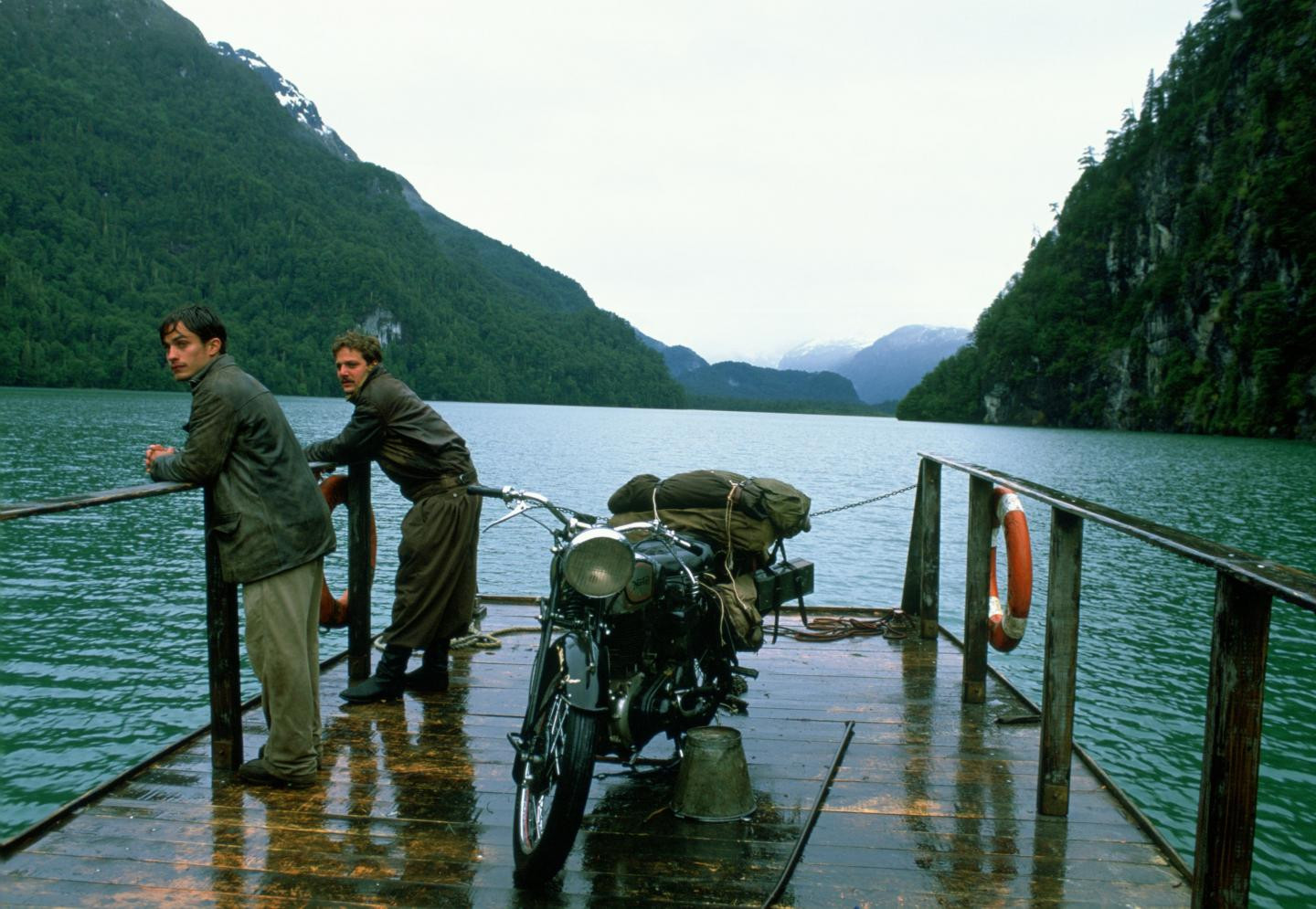 Gael García Bernal and Rodrigo de la Serna with a motorcycle on a boat in The Motorcycle Diaries (2004)
Gael García Bernal and Rodrigo de la Serna with a motorcycle on a boat in The Motorcycle Diaries (2004)
Brazilian director Walter Salles’ The Motorcycle Diaries portrays the transformative journey of medical student Ernesto ‘Che’ Guevara (Gael García Bernal) and his friend Alberto Granado (Rodrigo de la Serna) across South America in the early 1950s. The film is based on Guevara’s travelogue of the same title, supplemented by Granado’s memoir, Travelling with Che Guevara: The Making of a Revolutionary.
In stark contrast to the violent outlaw figures typically associated with biker movies, the two protagonists begin their adventure on a dilapidated 1939 Norton 500 motorcycle nicknamed ‘The Mighty One’. When their bike breaks down midway through their journey, they are forced to engage more deeply with the people they encounter, awakening them to the widespread poverty, hardship, and political oppression across the continent. The Motorcycle Diaries is a genuinely moving coming-of-age story, enhanced by stunning cinematography and compelling performances from Bernal and la Serna.

